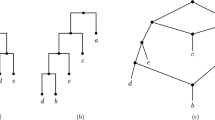Abstract
We present an exact algorithm for constructing minimal hybridization networks from multiple trees which is based on reducing the problem to the Boolean satisfiability problem. The main idea of our algorithm is to iterate over possible hybridization numbers and to construct a Boolean formula for each of them that is satisfiable iff there exists a network with such hybridization number. The proposed algorithm is implemented in a software tool PhyloSAT. The experimental evaluation of our algorithm on biological data shows that our method is as far as we know the fastest exact algorithm for the minimal hybridization network construction problem.
Access this chapter
Tax calculation will be finalised at checkout
Purchases are for personal use only
Similar content being viewed by others
References
Biere, A., Cimatti, A., Clarke, E.M., Strichman, O., Zhu, Y.: Bounded model checking. Adv. Comput. 58, 117–148 (2003)
Bonet, M.L., John, K.S.: Efficiently calculating evolutionary tree measures using SAT. In: Kullmann, O. (ed.) SAT 2009. LNCS, vol. 5584, pp. 4–17. Springer, Heidelberg (2009)
Bordewich, M., Semple, C.: Computing the minimum number of hybridization events for a consistent evolutionary history. Discret. Appl. Math. 155(8), 914–928 (2007)
Chen, Z.Z., Wang, L.: Hybridnet: a tool for constructing hybridization networks. Bioinform. 26(22), 2912–2913 (2010)
Heule, M.J.H., Verwer, S.: Exact DFA identification using SAT solvers. In: Sempere, J.M., García, P. (eds.) ICGI 2010. LNCS, vol. 6339, pp. 66–79. Springer, Heidelberg (2010)
Hölldobler, S., Nguyen, V.: An efficient encoding of the at-most-one constraint. Technical report, KRR Group 2013–04, Technische Universität Dresden, 01062 Dresden, Germany (2013)
Huson, D.H., Rupp, R., Scornavacca, C.: Phylogenetic Networks: Concepts, Algorithms and Applications. Cambridge University Press, New York (2010)
Morrison, D.A.: Introduction to Phylogenetic Networks. RJR Productions, Uppsala (2011)
Nakhleh, L.: Evolutionary phylogenetic networks: models and issues. In: Heath, L.S., Ramakrishnan, H. (eds.) Problem Solving Handbook in Computational Biology and Bioinformatics, pp. 125–158. Springer, Berlin (2011)
Nakhleh, L., Ruths, D., Wang, L.-S.: RIATA-HGT: a fast and accurate heuristic for reconstructing horizontal gene transfer. In: Wang, L. (ed.) COCOON 2005. LNCS, vol. 3595, pp. 84–93. Springer, Heidelberg (2005)
Park, H.J., Nakhleh, L.: MURPAR: a fast heuristic for inferring parsimonious phylogenetic networks from multiple gene trees. In: Bleris, L., Măndoiu, I., Schwartz, R., Wang, J. (eds.) ISBRA 2012. LNCS, vol. 7292, pp. 213–224. Springer, Heidelberg (2012)
Semple, C.: Hybridization Networks. Department of Mathematics and Statistics, University of Canterbury, New York (2006)
Wu, Y.: Close lower and upper bounds for the minimum reticulate network of multiple phylogenetic trees. Bioinformat. 26(12), i140–i148 (2010)
Wu, Y.: An algorithm for constructing parsimonious hybridization networks with multiple phylogenetic trees. J. Comput. Biol. 20(10), 792–804 (2013)
Acknowledgements
This work was financially supported by the Government of Russian Federation, Grant 074-U01. Authors would like to thank Igor Buzhinsky, Daniil Chivilikhin and Fedor Tsarev for helpful comments and conversations.
Author information
Authors and Affiliations
Corresponding author
Editor information
Editors and Affiliations
Rights and permissions
Copyright information
© 2015 Springer International Publishing Switzerland
About this paper
Cite this paper
Ulyantsev, V., Melnik, M. (2015). Constructing Parsimonious Hybridization Networks from Multiple Phylogenetic Trees Using a SAT-Solver. In: Dediu, AH., Hernández-Quiroz, F., Martín-Vide, C., Rosenblueth, D. (eds) Algorithms for Computational Biology. AlCoB 2015. Lecture Notes in Computer Science(), vol 9199. Springer, Cham. https://doi.org/10.1007/978-3-319-21233-3_11
Download citation
DOI: https://doi.org/10.1007/978-3-319-21233-3_11
Published:
Publisher Name: Springer, Cham
Print ISBN: 978-3-319-21232-6
Online ISBN: 978-3-319-21233-3
eBook Packages: Computer ScienceComputer Science (R0)




